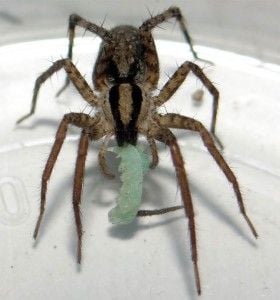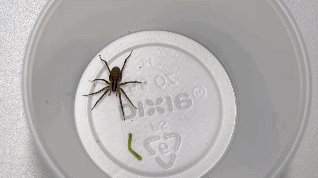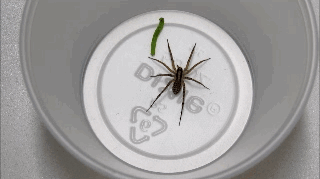Caterpillars Repel Predators With Second-Hand Nicotine Puffs
As far as spiders are concerned, caterpillars have a case of very bad breath
/https://tf-cmsv2-smithsonianmag-media.s3.amazonaws.com/filer/de/15/de15846f-452b-4f3a-b468-3ebc82f33d31/caterpillar.jpg)
Why bother making your own poison when you can simply repurpose it from the food you eat? That's the efficient, energy-saving strategy many caterpillars use, at least. Plants contain all sorts of nasty chemical defenses, and caterpillars adapted to handle these poisons readily recycle them to ward off everything from birds to ants to spiders.
Nicotine, too, is one of these potent chemicals. In animals are not adapted to handle it, it wreaks havoc on a receptor that mediates neuromuscular control. The tobacco hornworm, however, welcomes that poison. This little green caterpillar feasts on nicotine-containing leaves at levels that would kill other animals. Researchers have noticed that caterpillars that feed on more nicotine-rich plants tend to have lower levels of predation by ants and wasps than those that eat leaves with lower nicotine levels. But how exactly the insects use the chemical to deter those predators remained a mystery.
To find out more, researchers from the Max Planck Institute for Chemical Ecology in Germany tinkered with the genetics of tobacco plants. They engineered some plants to mess with the caterpillar's ability to recognize nicotine, silencing a nicotine-associated gene that would otherwise be turned on when the caterpillars gulped down that chemical. They then took an "ask the ecosystem" approach, planting the engineered tobacco plants in Utah, where they grow natively. The team let nature get to work, observing how the nicotine gene-silencing plants affected the wild caterpillars' run-ins with natural predators.
They quickly began observing that caterpillars were disappearing at night, but they were going missing almost exclusively on the gene-silencing plants rather than the normal, non-engineered ones. Upon further investigation, they found that nocturnal wolf spiders were the predators responsible for picking off the juicy nighttime caterpillar snacks. This observation confirmed that the particular gene silenced by the engineered plants likely plays an important role in the caterpillar's ability to utilize nicotine.

The researchers then moved their experiment into the lab, feeding the caterpillars nicotine-containing leaves and meticulously studying the molecular responses and nicotine concentration levels throughout the wriggling insects' bodies. Oddly, a small amount of consumed nicotine--about 0.65 percent--kept disappearing from the caterpillars systems and could not be accounted for, they were puzzled to find.
To figure out what the caterpillars might be up to, the researchers carried out observational lab studies, introducing caterpillars both with and without intact nicotine-enabling genes into a gladiator-like arena containing a hungry wolf spider. The spider's attack behavior finally provided the clue the team needed to crack the caterpillar's defensive secret. Spiders initially leapt on the nicotine gene-enabled caterpillars, but would then jump back before biting into their would-be prey, as shown in this video:

When spiders encountered caterpillars whose nicotine gene was silenced, however, they would happily chow down:

No nicotine traces appeared on the spider-repelling caterpillars' skin after the attack, leading the researchers to test the space around the caterpillars. Little puffs of nicotine, they found, surrounded the air around the traumatized caterpillars' heads. Further analysis revealed that the caterpillars siphon off a bit of nicotine from their diet in order to puff it out as a toxic halitosis cloud.
In other words, as far as spiders are concerned, the caterpillars have a case of very bad breath, the team describes in Proceedings of the National Academy of Sciences. In this case, at least, nature's equivalent to second-hand smoke turns out to be a life saver rather than a killer.
/https://tf-cmsv2-smithsonianmag-media.s3.amazonaws.com/accounts/headshot/Rachel-Nuwer-240.jpg)
/https://tf-cmsv2-smithsonianmag-media.s3.amazonaws.com/accounts/headshot/Rachel-Nuwer-240.jpg)